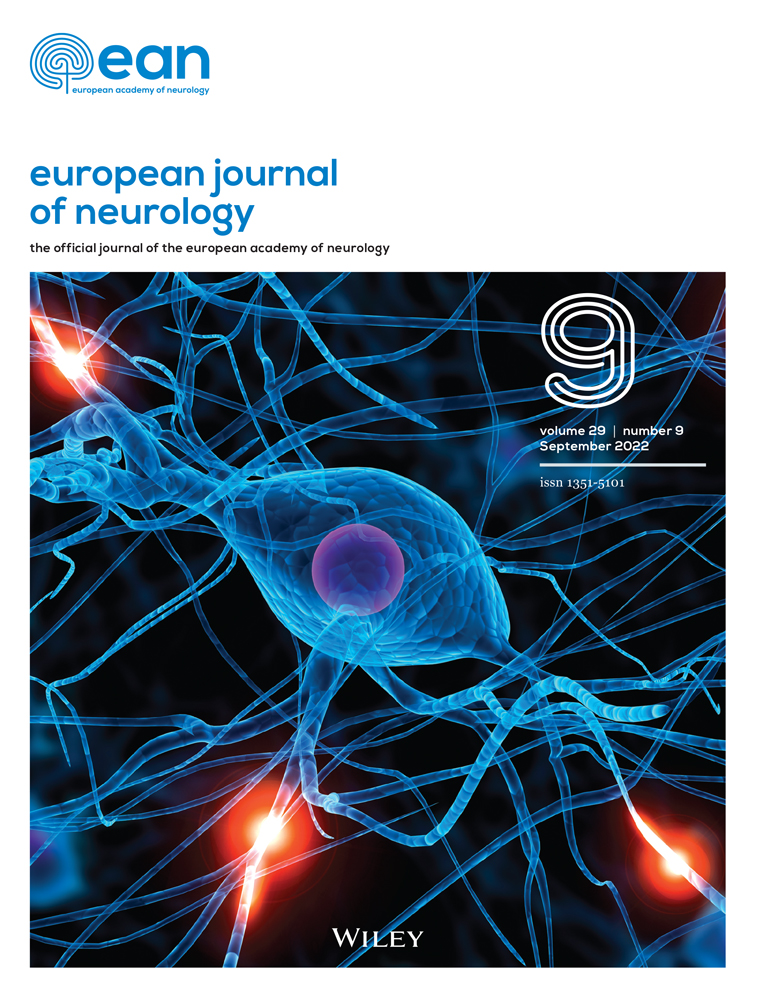The European Academy of Neurology Brain Health Strategy: One brain, one life, one approach
See commentary by V. Hachinski on page 2553.
Funding information
None
To view translations and video visit https://www.ean.org/ean/advocacy/brain-health/brain-health-strategy
Abstract
Background and purpose
Brain health is essential for health, well-being, productivity and creativity across the entire life. Its definition goes beyond the absence of disease embracing all cognitive, emotional, behavioural and social functions which are necessary to cope with life situations.
Methods
The European Academy of Neurology (EAN) Brain Health Strategy responds to the high and increasing burden of neurological disorders. It aims to develop a non-disease-, non-age-centred holistic and positive approach (‘one brain, one life, one approach’) to prevent neurological disorders (e.g., Alzheimer's disease and other dementias, stroke, epilepsy, headache/migraine, Parkinson's disease, multiple sclerosis, sleep disorders, brain cancer) but also to preserve brain health and promote recovery after brain damage.
Results
The pillars of the EAN Brain Health Strategy are (1) to contribute to a global and international brain health approach (together with national and subspecialty societies, other medical societies, the World Health Organization, the World Federation of Neurology, patients' organizations, industry and other stakeholders); (2) to support the 47 European national neurological societies, healthcare and policymakers in the implementation of integrated and people-centred campaigns; (3) to foster research (e.g., on prevention of neurological disorders, determinants and assessments of brain health); (4) to promote education of students, neurologists, general practitioners, other medical specialists and health professionals, patients, caregivers and the general public; (5) to raise public awareness of neurological disorders and brain health.
Conclusions
By adopting this ‘one brain, one life, one approach’ strategy in cooperation with partner societies, international organizations and policymakers, a significant number of neurological disorders may be prevented whilst the overall well-being of individuals is enhanced by maintaining brain health through the life course.
BRAIN HEALTH AND NEUROLOGY
The World Health Organization (WHO) defines brain health as the promotion of optimal brain development, cognitive health and well-being for all across the life course [1]. This definition implies that brain health is not just the absence of disease and fosters a person-centred approach focused on promotion, prevention, treatment, care and rehabilitation.
Whilst the definition of brain health is still debated [2], the concept that brain health is essential for the overall physical, mental and social health as well as well-being, productivity and creativity and coping with life situations (and critical life events) is undisputed. It is also widely accepted that brain health is a fundamental pre-requisite for mental health, even if both terms are sometimes erroneously seen as coterminous. In the aftermath of COVID lockdowns and the ensuing labour shortages in the USA, the importance of brain health to maintaining a functional workforce who can adapt and adjust to changes is becoming more apparent, as well as the consequent economic costs, with an estimated $2.5 trillion in productivity being lost globally due to poor brain health [3].
The years 2020–2022 mark a paradigm shift in the awareness of the importance of brain health with an extensive range of initiatives being taken by the WHO alongside those of patient groups, the European Academy of Neurology (EAN), the World Federation of Neurology (WFN) and other stakeholders [4]. The WHO created its Brain Health Unit in 2020, whilst in June 2021 the EAN launched a series of activities which share the ultimate goals and complement the WHO's launch of the Global Action Plan (GAP) on epilepsy and other neurological disorders, the first such GAP related to the brain and its disorders.
Neurologists diagnose, treat and manage neurological disorders and, like other physicians, are trained with a focus on diseases rather than health. However, in recent years, the importance of preventing neurological disorders has become better recognized. For instance, recent data suggest that up to 40% of dementias and 50% of strokes are potentially preventable [4, 5]. Accordingly, several societies and organizations have launched brain health strategies, which, however, are focused on single diseases (e.g., dementia, stroke) or functions (e.g., cognition) [6, 7].
With its Brain Health Strategy, the EAN aims at promoting a novel non-disease- and non-age-centred holistic and positive approach (one brain, one life, one approach) not only to prevent neurological disorders but also to preserve brain health and promote recovery after brain damage. In fact, multiple neurological disorders can lead on the one hand to similar symptoms and disabilities (e.g., seizures, headache, cognitive deficits, motor impairment, bladder and gait difficulties, depression, sleep–wake disturbances), whilst on the other hand single risk factors (e.g., hypertension, unhealthy diet, sleep apnoea) can predispose to multiple neurological disorders such as stroke and dementia for example [8].
- Preserve—promoting factors related to an individual's mental and physical activity such as keeping to a healthy diet, getting sufficient and good quality sleep, maintaining social interactions and promoting adaptive coping strategies.
- Protect and prevent—includes protective (as well as preventive) factors such as avoiding excessive alcohol consumption, not smoking, reducing sugar intake and controlling cholesterol levels. Hypertension, excessive weight, depression, diabetes, hearing impairment and cataracts are also factors that can have a significant impact on brain health.
- Plan—factors which must be addressed by policymakers including access to education, environmental factors such as air pollution, political situation, research strategies and socio-economic conditions.
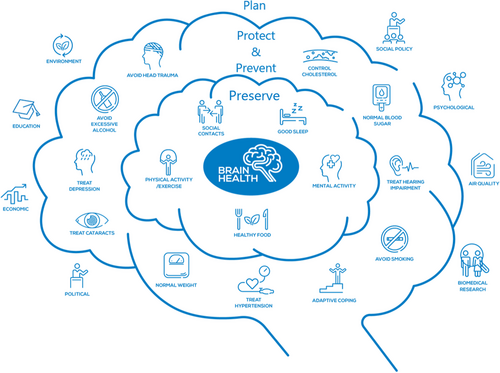
THE BURDEN OF NEUROLOGICAL DISORDERS IS HIGH AND INCREASING
Neurological disorders are the leading cause of disability and second leading cause of deaths worldwide [9]. According to the WFN, 70% of the burden falls on low- and middle-income countries.
In Europe, neurological disorders are the third leading cause of disability and deaths, the main driving forces being stroke, dementia and neurodegenerative disorders, and headaches [10]. In fact, according to the WHO and confirmed by recent studies [9], at least one in three people of all ages will suffer from a neurological disorder in their lifetime, making this the highest figure of all non-communicable diseases (Figure 2).
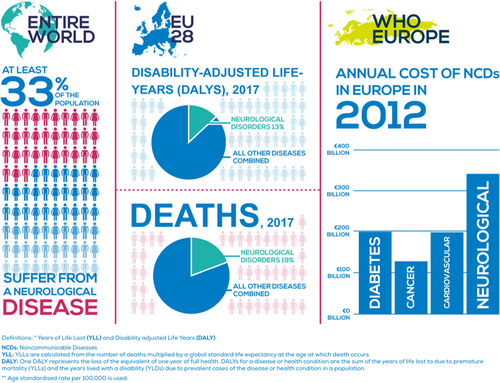
Mainly because of the epidemiological transition and of the aging population, the absolute number of deaths worldwide has increased by 39% and disability by 15% in the last 30 years [9]. The number of people aged 60 years or older across the world had already reached around 900 million in 2015 and is expected to grow to 2 billion by 2050. This trend will add to the growing burden of neurological disorders, especially when coupled with increasingly unhealthy lifestyles (lack of exercise, unhealthy diet, obesity, sleep loss) [11].
In addition, there is a secondary impact as the number of people occupied as caregivers will increase with an aging population and the increased prevalence of chronic neurological disorders.
In 2011 a systematic European study assessed the costs of brain disorders, in which the costs of neurological disorders were estimated to be around 300 billion Euros [12] with dementia, stroke, headache and sleep disorders as main drivers of cost.
More recently in 2019, the costs of dementia were estimated to represent about 1.5% of the world gross domestic product (GDP), or $1.3 trillion [13], and the costs of sleep disorders to range between 1% and 3% of the GDP of five Organization for Economic Cooperation and Development (OECD) countries [14]. The EAN launched a study in 2021 to systematically assess the economic burden of neurological disorders in Europe (first results will be presented during the 2022 EAN Congress).
The COVID-19 pandemic is also adding to the burden of neurological disorders as procedures deemed non-essential are delayed and care becomes more limited. In addition, several studies have shown that the nervous system is one of the main ‘targets’ of the SARS-CoV-2 virus and its complications, within the acute phase and in the so-called long-COVID phase. This has been shown by several publications, including those promoted by the EAN through its ENERGY consortium [15-17].
Major crises due to armed conflict (including the current invasion of the Ukraine by the Russian army), natural disasters or other emergencies also increase the burden of neurological disorders. Environmental crises such as chemical spills or radiation exposure can have especially heavy effects on the brain. Head trauma, psychosocial stress, economic restrictions and other consequences of war have a negative impact on both brain and mental health. In addition, the consequent shift in healthcare resources towards critical care leave patients with neurological disorders with reduced resources and care. This has the potential to lead to a long-term healthcare burden after the crisis, as chronic mental and neurological disorders emerge due to an adverse impact on brain health.
INITIATIVES TO REDUCE THE BURDEN OF NEUROLOGICAL DISORDERS
Several large-scale scientific initiatives have been funded in the last few years internationally such as the Human Brain Project in Europe [18], the BRAIN Initiative in the USA [19], and others in countries including Korea, Canada and Australia to foster our understanding of the healthy and sick brain, of diseases, their diagnosis and treatment.
Research on neurological disorders and underlying causes for them will profit not only from the above-mentioned campaigns, activities and the discovery (and availability) of innovative technologies but also from better ways (and a stronger culture) of international collaboration and data sharing.
The unprecedented growth of digital technologies may not only improve the diagnosis, monitoring and treatment of neurological disorders (e.g., via ‘teleneurological’ approaches) but also promote efficient and cost-effective approaches to promote prevention on an individual basis and in the home environment [20, 21].
The COVID-19 pandemic has shown how efficient international collaborations may be and may offer rapid scientific progress but also the pitfalls and limitations of such interactions [22]. The EAN has a long history of international collaborations and during the early days of the pandemic in spring 2020 called for an international collaboration to work towards better understanding of the neurological manifestations of COVID-19 [15].
At the political level, recent initiatives recognizing the importance of neurological disorders and of brain health have been emerging. The WHO member states are expected, as said above, to adopt the Intersectoral GAP on epilepsy and other neurological disorders at the 75th World Health Assembly to be held in May 2022. The GAP aims ‘to improve care, recovery, well-being and participation of people living with neurological disorders across the life-course’. With the GAP, the WHO considers neurological disorders, for the first time, as a distinct priority for which member states can define national actions defined also by specific steps and indicators.
In 2020, the EAN, together with the European Federation of Neurological Associations (EFNA), launched the OneNeurology initiative to stimulate collaborative advocacy, action and accountability for the prevention, treatment and management of neurological disorders worldwide and to support the WHO's GAP and promote its adoption. This initiative is persuading the European and the broader international community to see neurological disorders as a top priority.
CHALLENGES IN REDUCING THE BURDEN OF NEUROLOGICAL DISORDERS AND PROMOTING BRAIN HEALTH
Determinants of brain health
Despite major advances in fields such as multiple sclerosis, stroke, epilepsy, migraine, neuromuscular and sleep disorders, breakthroughs in the treatment of neurological disorders (e.g., Alzheimer's disease, Parkinson's disease, brain cancer, motor neuron diseases) remain insufficient [23]. This reflects a still fragmentary understanding of the basic/molecular mechanisms of many neurological disorders [24]. In addition, the role of psychological, socioeconomic and environmental (pollution, climate changes) factors is underestimated and understudied. Consequently, current diagnostic criteria and treatment approaches are inappropriate for several neurological disorders.
Neurology workforce
Currently, there are not enough neurologists. The WFN has estimated that only 25% of the world has access to more than two neurologists per 100,000 people [25]. In a study conducted by the EAN, a total of 85,000 neurologists were recorded for 900 million citizens across Europe (Figure 3). On average, this means 10,000 patients per neurologist [26]. There are also major regional differences within Europe in the prevalence of neurological disorders and size of the neurological workforce. The COVID-19 pandemic has caused additional burden disrupting cross-sectoral services for neurological disorders [27]. Furthermore, it is recognized that enhanced neurological training and resources for physicians at primary care level as well as other physicians outside neurology will be crucial to ensure adequate care for patients, as relying on specialists alone will not be sufficient.
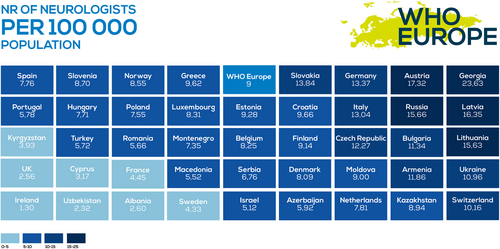
Research funding
Funding for research on mechanisms, management and prevention of neurological disorders is insufficient and, in many countries, prevention is still not a crucial pillar of national health strategy [28, 29]. In addition, knowledge about determinants of brain health is increasing but is still insufficient.
Holistic (non-disease- and non-age-centred) and positive approach to brain health
A scientific assessment of brain health as a person-centred state which includes multiple functional dimensions is almost completely lacking [30]. In fact, most efforts have so far been disease- and age-centred. Some publications have suggested multidimensional tools; however, validated measures (scores) of brain health from a holistic biopsychosocial perspective are still to be developed [31].
Prevention of neurological disorders
The evidence available for efficient and cost-effective prevention [20, 21], which is starting to be available for stroke and Alzheimer's disease and other dementias, is lacking for most of the remaining neurological disorders.
Awareness
Awareness of the burden of neurological disorders is lacking, in stark contrast to that of cancers and cardiovascular diseases. A recent international, online cross-sectional survey has also documented relevant differences in the public perception of brain health [32].
Better understanding of brain health and neurological disorders would also help to remove stigmas associated with many conditions. Furthermore, global knowledge that there is no health without brain health should find ways to be disseminated at all scientific and lay levels.
THE EAN BRAIN HEALTH STRATEGY: ONE BRAIN, ONE LIFE, ONE APPROACH!
The EAN recognizes the urgent need to promote brain health and prevent neurological disorders across the life span and launched its Brain Health Campaign in 2021 (with a series of communications, conferences and talks during the annual congress). This campaign draws attention to key preventative measures identified thus far as having a major impact on the burden of neurological disorders if addressed.The EAN's 47 National Neurological Societies (Figure 4), as well as its corresponding members outside Europe, are key partners in implementing this strategy, bringing it to the attention of national health authorities as well as neurology and other non-neurology stakeholders, creating a network of engaged and committed actors to develop and/or implement national action plans. At national level, Norway is the first country in Europe to have launched its Brain Health Strategy 2018–2024 [29].
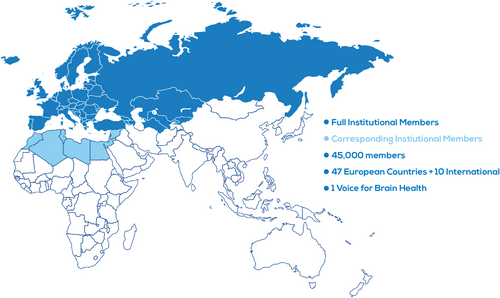
At the global level, the EAN is already supporting the WHO-led GAP in which brain health is a key priority, whilst also contributing to the WFN's Brain Health initiative as a partner. Furthermore, the EAN Brain Health Strategy will take account of the OECD's Brain Capital Grand Strategy for investments in a ‘Brain Health in All Policies’ approach for post-COVID economic renewal, reimagination and long-term economic resilience [30].
The EAN will also work closely with the EFNA in integrating patient perspectives and bridging between national neurological societies and national patient associations, whilst the European Brain Council (EBC) coordinates communication amongst National Brain Councils. EAN's roles in the EBC coordinated project on the European Brain Research Area (EBRA) and Policy Roadmap on Brain Health in Europe, as well as the EBRAINS Research Infrastructure that will power brain research in Europe, will also be leveraged to foster brain health. Finally, the EAN will ensure that the Brain Health Strategy links to other EU initiatives such as the EU Pharmaceutical Strategy and the European Health Data Space.
THE FIVE PILLARS OF THE EAN BRAIN HEALTH STRATEGY
The EAN Brain Health Strategy consists of five main pillars which support the goals and aims.
Contribute to a global and international brain health approach
The EAN is one of the driving forces in the elaboration of a new concept and creation of an appropriate frame for a holistic and global/international brain health approach. EAN is the home of all neurology subspecialities and national neurological societies in Europe. Through its established links with the WFN, the WHO and other stakeholders including other specialists (e.g., psychiatrists, cardiologists, oncologists, psychologists, preventive medicine specialists), the EBC, the EFNA, academic institutions and industry, the EAN aims to make brain health a top priority amongst health professionals, researchers, policymakers and the general public.
Supporting international and national policymaking
The EAN, together with the EU, the WHO and other continental organizations, supports policy development in the 47 national European member societies to promote the GAP and integrated, people-centred, affordable and effective brain and brain health campaigns.
Fostering research
- identify the gaps in the current brain health concept and approach
- apply the definition of brain health in research settings
- understand determinants and predictors of brain health
- create multidimensional metrics to assess brain health
- assess interventions (tests, polls, apps) to promote brain health
- study the gaps between evidence and healthcare delivery
Promoting education
The EAN engages in the education of medical students and next generation neurologists using educational programmes that stress the importance of brain health and prevention. General neurologists, general practitioners and other medical specialists and health professionals as well as neurological patients, caregivers and the general public are also important for the EAN to ensure adequate and affordable prevention and care of neurological disorders. Such educational programmes will also need to take an interdisciplinary approach, including nurses, psychologists, speech–language pathologists and many other professionals who are the key to diagnosis, treatment and prevention of brain disorders.
Raising public awareness
Together with partner societies, international organizations and healthcare authorities, the EAN promotes brain health through press and media campaigns, including the use of social and informational material for the public. A crucial component will be to address and dispel stigmas associated with neurological disorders.
CONCLUSION
Whilst there are clearly challenges to overcome in addressing the burden of neurological disorders, there are also substantial inroads to be made by taking a more comprehensive approach towards brain health, focusing on health and prevention in addition to diagnosis and treatment.
The EAN Brain Health Strategy emerged from the COVID-19 pandemic, as it became apparent that health systems must adapt urgently and build resilience in an unprecedented health situation. It was these conditions which prompted the EAN to emphasize brain health as a means of easing significant strain on these health systems by reducing one of the largest healthcare burdens, neurological disorders.
By adopting this ‘one brain, one life, one approach’ strategy in cooperation with partner societies, international organizations and policymakers, a big step is being taken towards realizing ‘a state in which every individual can realize their own abilities and optimize their cognitive, emotional, psychological and behavioural functioning to cope with life situations’ [1].
AUTHOR CONTRIBUTIONS
Claudio L Bassetti: Conceptualization (equal); supervision (equal); writing – original draft (equal). Mathias Endres: Conceptualization (equal); writing – review and editing (equal). Anja Sander: Writing – review and editing (supporting). Michael Crean: Project administration (equal); writing – original draft (supporting); writing – review and editing (lead). Sumathi Subramaniam: Project administration (supporting); writing – original draft (supporting). Vanessa Carvalho: Conceptualization (equal); writing – review and editing (supporting). Giovanni Di Liberto: Conceptualization (equal); writing – review and editing (equal). Oscar Franco: Conceptualization (equal); writing – review and editing (equal). Yolande AL Pijnenburg: Conceptualization (equal); writing – review and editing (equal). Matilde Leonardi: Conceptualization (equal); writing – review and editing (equal). Paul Boon: Conceptualization (equal); supervision (equal); writing – original draft (equal).
CONFLICT OF INTEREST
None.
Open Research
DATA AVAILABILITY STATEMENT
Data sharing not applicable to this article as no datasets were generated or analysed during the current study



